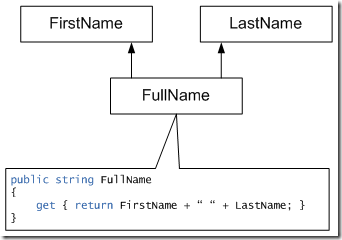|
|
Dependent and independent object data
For example, a Person object has three properties: FirstName, LastName, and FullName. The user can directly set the first and last name, but the full name is derived. The user has no direct control over the full name. She can only influence it by changing the first or last name. Sometimes it's hard to see the difference between dependent and independent data. Both kinds of data change in response to a user action. The key question is not "when does it change", but rather "what determines its value". The UI might allow the user to enter a full name. When she types a new value, the UI parses the text she enters and determines the first and last names. It sets these two independent properties, and then calculates the full name. If the user entered well-formed input, the calculated output will be exactly the same. If not, the system will have "fixed" her mistakes (extra spaces, inconsistent formatting, etc.) The number of independent properties is exactly equal to the number of degrees of freedom that an object has. Ideally, independent properties are unconstrained. Constraints are codified in the dependent properties. Keep the data flowing Another strategy is to keep a marker for dependent data that is out-of-date. When the independent data changes, set the marker. When someone asks for the dependent data, check the marker. This postpones the update and therefore avoids redundancy. When dependent data in one object relies upon independent data in another, things get even more interesting. If you take the direct approach of notifying the dependent object from the independent one, you end up with tightly coupled objects. The observer pattern breaks that coupling. There are several other patterns that offer benefits over observer (including my own) that are too numerous to list here. Now add to the mix the fact that dependent data may rely on other dependent data. So a change to an independent property should result in the update of all of its direct and indirect dependencies. This could be accomplished through cascading notifications, whereby the direct dependent upon receipt of notice turns around and notifies the indirect dependent. But to avoid potential redundancy or cycles, this is more often handled through dependency analysis. That is certainly too deep for this post. Ebb and flow My synchronization framework starts with this fundamental concept. All object behavior is either dependent or independent. |



